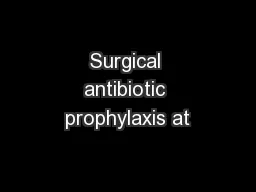

Moi Teaching amp Referral Hospital Rose Kakai 1 Barrack Ayumba 2 Damaris Lagat 2 Eveline Wesangula 3 Sam Kariuki 4 1 Maseno University 2 Moi University 3 Ministry of Health ID: 754885
Download Presentation The PPT/PDF document "Surgical antibiotic prophylaxis at" is the property of its rightful owner. Permission is granted to download and print the materials on this web site for personal, non-commercial use only, and to display it on your personal computer provided you do not modify the materials and that you retain all copyright notices contained in the materials. By downloading content from our website, you accept the terms of this agreement.
Slide1
Surgical antibiotic prophylaxis at Moi Teaching & Referral Hospital
Rose Kakai
1
, Barrack Ayumba
2
,
Damaris
Lagat
2
,
Eveline
Wesangula
3
, Sam Kariuki
4
1
Maseno University,
2
Moi University,
3
Ministry of Health
4
Kenya Medical Research InstituteSlide2
Introduction
Worldwide, over 230m operations performed annually
SSIs one of the most important causes of healthcare associated infections
SSI is an infection occurring at the operation site within 30
dys
of the procedure
In GARP-Kenya situation analysis
(2011)
, hospital antibiotic use was one of the critically important areas of policy action
Rationale is, in order to control AMR in hospitals, the most important steps are to reduce and rationalize hospital prescribingSlide3
Introduction --------
Why give pre-operative antibiotics?
The operation is the major period of bacterial contamination of the site
There is a strong evidence base for single dose from
Experimental (animal) studies
Clinical research in East Africa
International research + recommendations
National Clinical Guidelines recommend itSlide4
Introduction --------
Potential benefits of single dose
regimen
Reduce
rate of wound infections
Reduce costs to pts + hospital
Reduce overall usage of
antibiotics cf. R
Better injection safety
Less nursing time giving antibiotics in wardsSlide5
Introduction --------
Statement of the problem:
Surgical prophylaxis is beneficial in prevention of SSIs
identified as one of the areas where antibiotics are often overused
Objective:
To rationalize use of surgical AP at MTRH
Specific objectives:
Determine:
Use
of antibiotics in surgical pts
Rate of SSI
Pathogens
AMR in
pts with SSI
Outcome measure:
Proportion of pts receiving rational (correctly timed and dosed) APSlide6
Methods
Study site:
MTRH surgical patients
Design:
L
ongitudinal
observational
study
Inclusion criteria:
Surgical wound class I (clean) and II (clean/contaminated)
Dependent variable:
Pre-operative single dose regimen
Independent variables:
Use of antibiotics in surgical pts, Rate of SSI, Pathogens and
AMR in
pts with SSI
Limitation:
Failure to follow up and detect post operative infections after pts were discharged
Ethical consideration:
Approval obtained from IRECSlide7
Methods -- Data collection procedure
First seminar
for planning
Immediately after ethical and other relevant
approvals
Review of:
research findings
Kenya national clinical guidelines (2009)
Kenya national IPC guidelines (2010)
Experiences of other hospitals e.g.
Thika
Level 5
(June 2010 – Feb 2011)
Show strong evidence to support pre-operative single-dose (AP), using similar antibiotics
Agreed that there was need for locally appropriate AP policy at MTRH, hence
develop a
process chart
and
drug regime
for the proposed policy
Process chart describes; r
responsibilities’ for different hospital staff, materials needed and sequence of events
Collection of lab and bio data from date of 1
st
seminar to end of study is ongoing to monitor
antibiotic use, changes in SSIs,
pathogens and resistance
ratesSlide8Slide9Slide10
Methods -- Data collection procedure
Second seminar
for Planning
2 months after 1
st
seminar
Process chart and drug regime drafts presented and discussed
Main drug for AP is
Ampicillin
b
ecause it
Has good bacterial coverage
Is (relatively) cheap
Has no major side-effects or interactions
Is safe in high doses
Formal application to
Hospital Director
requesting approval to implement use of the proposed process chart and drug regime
Approval granted to proceed with the implementation and it is ongoingSlide11
Methods -- Data collection procedure
Third seminar
for Monitoring and Evaluation
Expected to be held 11 months after implementation of proposed surgical AP policy
To evaluate effects of the change in the policy with regard to;
Use of antibiotics in surgical pts
Rate of SSI
Pathogens
AMR
in pts with SSISlide12
Methods -- Data collection procedure
Fourth final seminar
for Sustainability
3 months write up
Discuss:
Final
results and challenges
Hence long term sustainability of the policySlide13
Preliminary resultsTotal of 446 surgical pts sampled
160 (58.35) females
193 (43%) aged 40 – 65 yrs old
Most common surgeries were 164 (36.8%) general and 147 (32.9%) CS
SSI reported in 8 (1.8%) pts
Post operative AP prescribed for 136 (30.5%) pts ranging from 3 – 5 days duration
Inconsistent access to
ampicillinSlide14
Conclusion
Pre-operative single dose beneficial
Main
challenges
Drug stock outs
Prescription of post-operative antibioticsSlide15
RecommendationMeasures e.g. CME on AMR aimed at rational use of surgical prophylactic drugs is necessary
to strengthen sustainable practices regarding APSlide16
AcknowledgementRamanan
Laxminarayan
, CDDEP
Thank
you